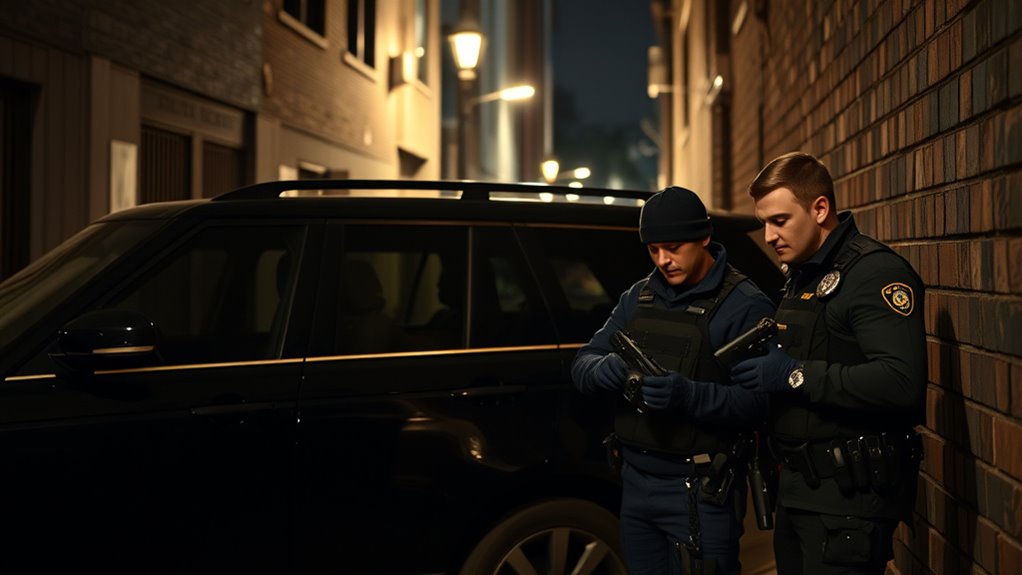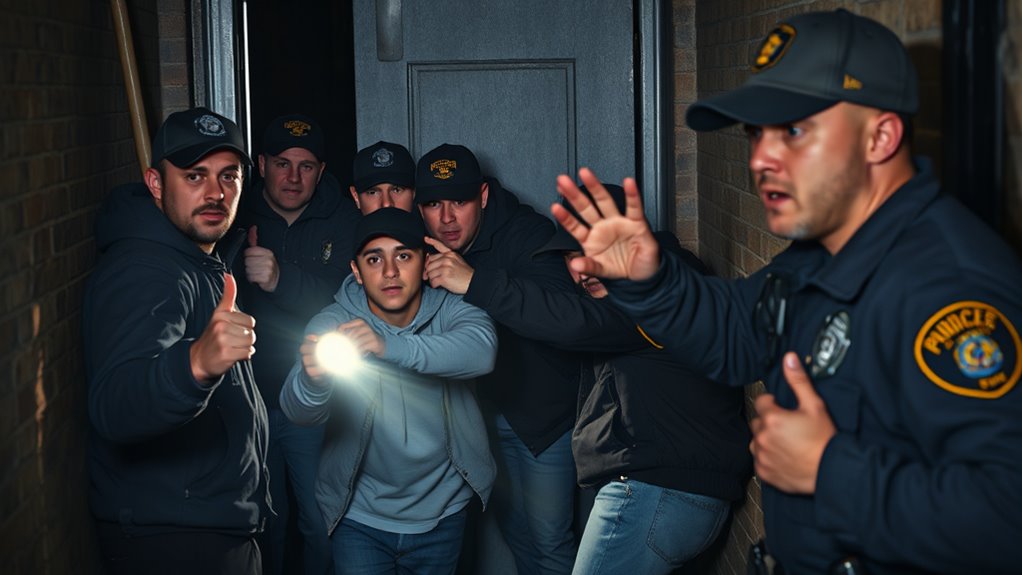Police plan surprise arrests by carefully coordinating informants and surveillance teams, ensuring they gather accurate intelligence about suspects’ routines and locations. They use discreet communication methods to share sensitive information securely and avoid detection. Combining physical and electronic surveillance helps confirm suspect movements and timing. The operation is meticulously timed to catch suspects off guard while maintaining strict secrecy throughout. To learn how officers execute these tactics smoothly, stick around for the details that follow.
Key Takeaways
- Police gather detailed intelligence from informants to understand suspect routines and locations.
- Discreet communication methods are used to securely coordinate informants and surveillance teams.
- Surveillance techniques, including physical stakeouts and electronic monitoring, confirm suspect activities in real time.
- Timing of arrests is carefully planned to coincide with suspect vulnerabilities and routine breaks.
- Multiple teams are synchronized to execute the surprise arrest swiftly while maintaining operational secrecy.

Have you ever wondered how law enforcement gathers evidence without alerting suspects? It’s a complex process that relies heavily on meticulous planning, especially when it comes to undercover warrant operations. These operations are designed to catch individuals off guard, ensuring arrests happen swiftly and discreetly. To pull this off successfully, officers depend on a combination of informant coordination and surveillance techniques. Informants play a vital role—they provide inside information about the suspect’s activities, whereabouts, and routines. By carefully managing these relationships, law enforcement can gather intelligence essential for planning a surprise arrest. Informants are often trusted sources who might have been involved in or familiar with the suspect’s criminal activities, making their insights invaluable. Coordinating with informants involves building rapport, verifying information, and ensuring their safety, all while keeping their identities confidential to prevent the operation from falling apart. Additionally, understanding the importance of discreet communication methods helps maintain the operation’s secrecy and effectiveness.
Surveillance techniques complement informant coordination perfectly. Once officers have enough intel, they deploy various surveillance methods to monitor the suspect’s movements in real time. This can include physical stakeouts, where officers observe from a distance, or electronic surveillance, such as wiretaps and hidden cameras. These techniques help officers confirm the suspect’s location, identify their associates, and understand their routines. The goal is to track their movements closely enough to anticipate when they’ll be at a particular place, such as a residence or meeting spot, so that law enforcement can execute the warrant precisely when the suspect is vulnerable. These surveillance methods are often covert, designed not to alert the suspect that they’re being watched, which could jeopardize the entire operation.
The key to a successful undercover warrant operation lies in the seamless integration of informant insights and surveillance data. Officers plan the arrest meticulously, choosing the right moment when the suspect is least likely to notice or escape. This often involves coordinating multiple teams—some handling surveillance, others ready to make the arrest—ensuring everyone acts in unison. The operation’s success depends on the accuracy of the intelligence gathered and the stealth of the execution. By leveraging informant coordination and advanced surveillance techniques, law enforcement agencies can carry out surprise arrests that dismantle criminal operations efficiently and safely, all while minimizing the risk of alerting the suspect ahead of time.
Frequently Asked Questions
How Do Officers Select Targets for Undercover Warrant Operations?
You might wonder how officers choose targets for undercover warrant operations. They rely on surveillance techniques and intelligence gathering to identify suspects involved in illegal activities. By analyzing patterns and gathering information, they narrow down potential targets who pose significant threats or are involved in ongoing crimes. This careful selection helps guarantee the operation’s success, allowing officers to plan surprise arrests that effectively disrupt criminal networks.
What Safety Measures Are in Place During Surprise Arrests?
You might worry about safety during surprise arrests, but police use advanced surveillance techniques and strict public safety protocols to protect everyone involved. They coordinate closely, keeping bystanders safe and minimizing risks. Officers wear protective gear, plan escape routes, and communicate constantly to adapt to changing situations. This careful preparation guarantees that, even in high-stakes moments, safety remains the top priority, preventing harm and ensuring a smooth operation.
How Long Do Undercover Operations Typically Last?
Undercover operations can last from a few days to several weeks, depending on the target and the complexity of the case. During this time, officers use various undercover tactics and surveillance techniques to gather evidence and monitor suspects discreetly. You should comprehend that these operations aim to build a solid case while minimizing risks, so their duration varies based on how long it takes to guarantee safety and gather enough information for a successful arrest.
Are There Risks of Informants Being Exposed?
You wonder if informant betrayal or operational leaks could blow your cover. These risks are real, and if an informant’s identity slips, it could jeopardize the entire operation. Police take precautions, but the threat of exposure lingers, making every move tense. An unexpected leak could lead to dangerous consequences, so officers constantly weigh the potential for betrayal against their tactics, knowing one slip-up could turn the operation into chaos.
How Do Police Ensure Operational Secrecy?
You might wonder how police keep operational secrecy during undercover warrant operations. They rely on strict surveillance tactics and careful planning to prevent leaks. Officers limit information sharing and use covert communication methods. Legal considerations also guide their actions, ensuring operations stay within the law while maintaining secrecy. This combination helps protect the integrity of the mission and prevents suspects from discovering the plan before authorities make the arrest.
Conclusion
As you observe these covert efforts, remember that behind the scenes, authorities craft delicate plans to maintain peace and order. Their surprise acts serve as gentle whispers of justice, ensuring safety without unnecessary disturbance. While the details remain hidden, their goal is to guide society toward harmony, like a quiet current beneath the surface. In the end, these silent steps help keep the community balanced, encouraging trust in the unseen hand of law enforcement.









